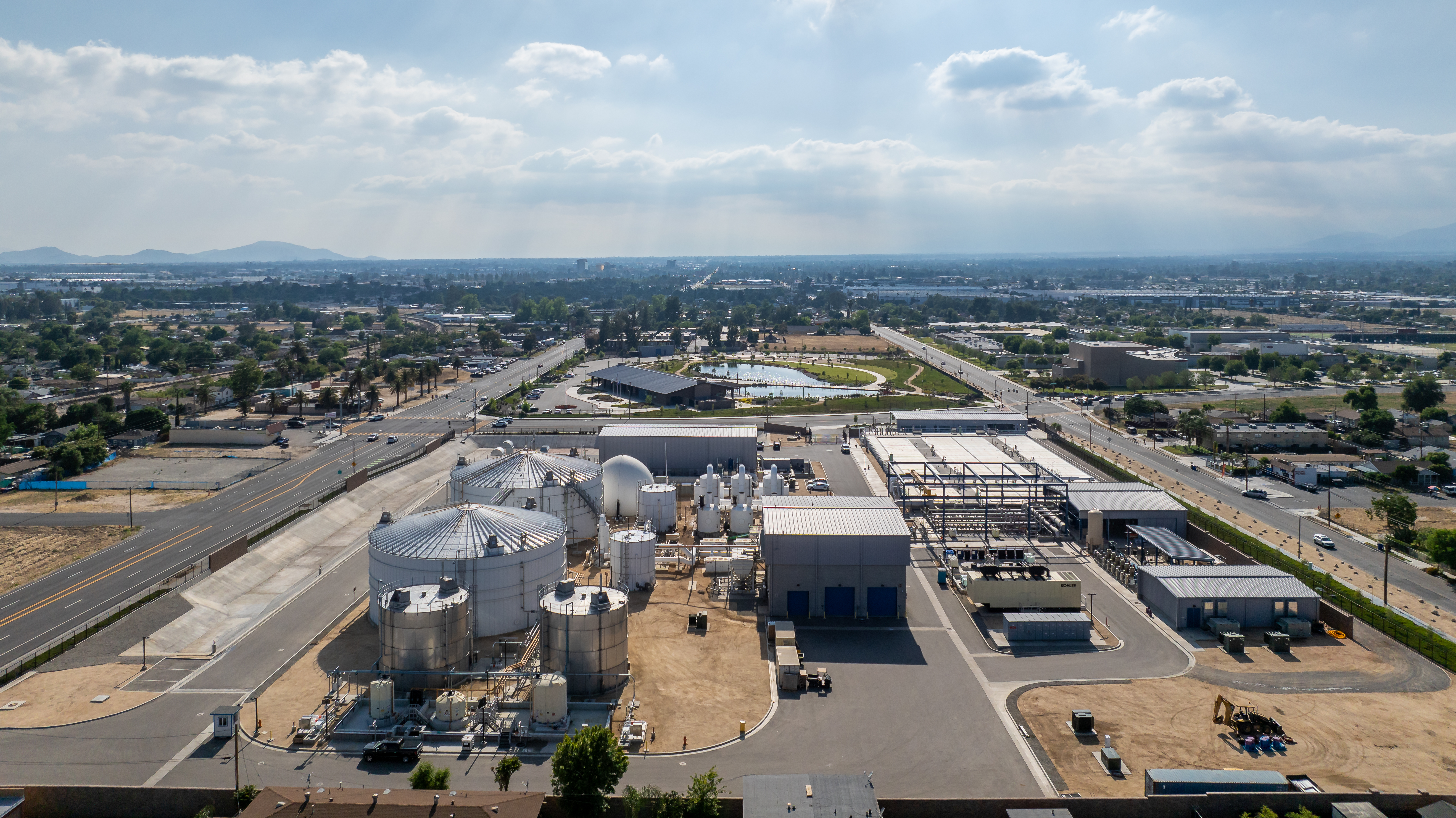Sterling Natural Resource Center
Award
Water/Wastewater Treatment Project
Description
EXECUTIVE SUMMARY
East Valley Water District (EVWD) was formed in 1954 and provides water and wastewater services to over 108,000 residents within its 30.1 square mile area, including customers in the City of Highland and portions of both the City and County of San Bernardino. EVWD’s primary source of supply is groundwater from the local Bunker Hill Basin, which is at historic low levels due to climate change. In December 2023, EVWD completed construction of the project known as the Sterling Natural Resource Center (SNRC), a new 20-acre state-of-the-art wastewater treatment and community facility located in San Bernardino, California. The SNRC was developed for the community served by EVWD with a vision for constructing a water recycling facility that enhanced quality of life, improved services for residents and businesses, maximized resources, and provided a new reliable source of water for the region.
COMMITMENT TO INOVATION
EVWD’s vision for the SNRC focused on integrating advanced wastewater treatment technologies, on-site renewable energy generation, new community green spaces, and facility aesthetics that enhance the neighborhood. The facility serves as a resource-efficient asset that exemplifies the principle of resource optimization for wastewater treatment infrastructure and redefines wastewater treatment plants as integral, visible parts of the communities they serve, highlighting the potential for infrastructure projects to support sustainable urban development.
For decades, wastewater treatment facilities have been designed to remain hidden from the communities they serve. EVWD built the SNRC to provide benefits that go beyond the typical commitment of public utilities. The SNRC is made up of two parcels, an Administrative Center and Wastewater Treatment Facility that together serve and enhance the community by providing:
• Drought-proof supply: The SNRC is capable of recycling up to 8 million gallons of wastewater per day for groundwater recharge to replenish the Bunker Hill Groundwater Basin. Water produced will benefit EVWD customers and over 600,000 residents that rely on groundwater as a source of water.
• Demonstration garden: New community outdoor space with a picnic area, walking paths, and a display of water efficient plants and trees.
• Community partnerships: EVWD created a career pathway program and partnered with San Bernardino City Unified School District to provide high school students with hands-on training and career pathway experiences in water and wastewater treatment.
• Special event spaces: The Administrative Center includes a banquet hall and conference rooms that can be utilized by customers and organizations to host meetings, conferences, trainings, and other special events.
• Neighborhood improvements: EVWD committed to improving the community outside of its walls. Improvements included new sidewalks, crosswalks, street lights, and repaved streets.
WASTEWATER TREATMENT PLANT
The SNRC integrates advanced Membrane Bioreactor (MBR) and Ultraviolet (UV) disinfection technologies, significantly improving groundwater replenishment quality. This approach showcases EVWD’s commitment to technological innovation environmental stewardship, and enhancing sustainable water management. The combination of leading technology is the first application in California. MBR technology combines biological treatment with membrane filtration, effectively removing a wide range of contaminants more efficiently than traditional methods. Its compact design reduces physical footprint by merging treatment steps and omitting large settling tanks, while delivering high-quality effluent for groundwater recharge. UV disinfection complements MBR by using ultraviolet light to inactivate pathogens, including those resistant to chlorine, without chemicals. This environmentally friendly method ensures treated water is safe and free from chemical residues. Together, MBR and UV technologies offer superior water treatment, aligning with sustainability and efficiency goals.
The deployment of MBR technology and the strategic combination of subterranean and above-ground equipment facilitates the SNRC’s integration into an urban neighborhood, showcasing a creative use of land. Traditionally, a facility with an 8 MGD capacity would need up to 16 acres solely for process equipment. However, this treatment facility is efficiently contained within a 9-acre site. Beyond its core design components, the SNRC incorporates innovative features that elevate its overall excellence.
• Advanced Noise and Odor Control Systems: Zero emissions achieved through design, ensuring neighborhood integration. Acoustical studies prompted strategic placement to redirect noise upwards, reducing community impact.
• Contained Headworks Facility: Noise and odor containment contribute to the facility’s unobtrusive presence in the community.
RENEWABLE WASTE MANAGEMENT
The SNRC incorporates co-digestion of wastewater sludge with regionally sourced food waste. This innovative approach facilitates the dual objectives of managing solid waste and enhancing renewable energy production. By diverting high-grade food waste from landfills, the initiative aids in reducing carbon emissions and minimizing waste, aligning with environmental sustainability goals.
The combination of these elements results in the recycling of nearly all influent material, virtually eliminating organic waste from the process. These aspects contribute to environmental sustainability, and resource efficiency.
NET ZERO ENERGY
The facility achieves net-zero energy consumption by producing 3 megawatts on site. The power is generated from wastewater sludge and food waste, feeding it into on-site gas generation, reflecting a commitment to sustainability and renewable energy. Incorporating a food waste receiving system and advanced biosolids processing, the project emphasizes sustainable waste management and resource recovery. Additionally, all the plant processes were designed to be the most energy efficient to reduce greenhouse gases.
CONCLUSION
The new treatment plant is the first water recycling facility to utilize this advanced combination of technology in California. The SNRC integrates innovative technologies, a multi-benefit approach, and a focus on resource maximization to create a facility that models sustainable infrastructure development, setting a high standard for water resource management projects that go beyond industry standards.
